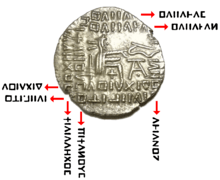Royal formula of Parthian coinage

the inscription "ΒΑΣΙΛΕΩΣ ΒΑΣΙΛΕΩΝ ΑΡΣΑΚΟΥ ΕΥΕΡΓΕΤΟΥ ΔΙΚΑΙΟΥ ΕΠΙΦΑΝΟΥΣ ΦΙΛΕΛΛΗΝΟΣ" in a highly stylized variant of the Greek alphabet[1]

Royal formula on the reverse of a coin of Pacorus I
The Greek inscription "ΒΑΣΙΛΕΩΣ ΒΑΣΙΛΕΩΝ ΑΡΣΑΚΟΥ ΕΥΕΡΓΕΤΟΥ ΔΙΚΑΙΟΥ ΕΠΙΦΑΝΟΥΣ ΦΙΛΕΛΛΗΝΟΣ" means "[coin] of king of kings Arsaces, the benefactor (Euergetes), the just (Dikaios), the illustrious (Epiphanes), friend of the Greeks (Philhellen)". It is found on coins of the Parthian Empire, starting from the reign of Artabanus I.[1]
The name Arsaces indicates the Arsacid dynasty and appears until the period of Phraates IV.[2]
Transliteration
BASILEOS BASILEON ARSAKOU EUERGETOU DIKAIOU EPIPHANOUS PHILHELLENOS.[3][4][5]
Literal translation
- ΒΑΣΙΛΕΩΣ ΒΑΣΙΛΕΩΝ = Of the King of kings
- ΑΡΣΑΚΟΥ = Arsaces (genitive form)
- ΕΥΕΡΓΕΤΟΥ = the Benefactor (genitive form)
- ΔΙΚΑΙΟΥ = the Just (genitive form)
- ΕΠΙΦΑΝΟΥΣ = the Illustrious (genitive form)
- ΦΙΛΕΛΛΗΝΟΣ = the Friend of the Greeks (genitive form)
References
- 1 2 A catalogue of the Greek coins in the British Museum - "Catalogue of coins of Parthia", by Warwick William Wroth, 1903, p. 201, Oclc-id 3187578
- ↑ Warwick William Wroth, 'On the Rearrangement of Parthian Coinage', N. C., 1900, pp. 181-202
- ↑ "Drachm - Vologases III, Sellwood Type 78 - Ecbatana, Persia (ancient)". En.numista.com. Retrieved 21 August 2017.
- ↑ "Drachm - Phraates IV, Sellwood Type 54, Persia (ancient)". En.numista.com. Retrieved 21 August 2017.
- ↑ "Coin". British Museum. Retrieved 21 August 2017.
This article is issued from
Wikipedia.
The text is licensed under Creative Commons - Attribution - Sharealike.
Additional terms may apply for the media files.